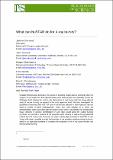| dc.contributor.author | Chenevez, Jerome | |
| dc.contributor.author | Tomsick, John A. | |
| dc.contributor.author | Paerels, Frits | |
| dc.contributor.author | Christensen, Finn Erland | |
| dc.contributor.author | Chakrabarty, Deepto | |
| dc.date.accessioned | 2019-03-12T14:12:07Z | |
| dc.date.available | 2019-03-12T14:12:07Z | |
| dc.date.issued | 2013-07 | |
| dc.identifier.uri | http://hdl.handle.net/1721.1/120921 | |
| dc.description.abstract | Unstable thermonuclear burning on the surface of accreting neutron stars is commonly observed as type I X-ray bursts. The flux released during some strong bu rsts can temporarily exceed the Eddington limit, driving the neutron star photosphere to such large radii that heavy-element ashes of nuclear burning are ejected in the burst expansion wind. We have investigated the possibility of observing with NuSTAR some X-ray bursters selected for their high burst rate and trend to exhibit so-called superexpansion bursts. Our main ambition is to detect the photoionization edges associated with the ejected nuclear ashes, and identify the corresponding heavy elements. A positive identification of such edges would probe the nuclear burning processes, and provide a measure of the expans ion wind velocity as well as the gravitational redshift from the neutron star. Moreover, we expect that the high sensitivity of NuSTAR in hard X-rays will make it possible to study the behavi our of the accretion emission during the bursts, which is an important parameter to constrain the properties of the X-ray burst emission and thermonuclear burning. | en_US |
| dc.description.sponsorship | European Space Agency. PRODEX Programme (contract N: 90057) | en_US |
| dc.publisher | Sissa Medialab | en_US |
| dc.relation.isversionof | http://dx.doi.org/10.22323/1.176.0048 | en_US |
| dc.rights | Creative Commons Attribution-Noncommercial-Share Alike | en_US |
| dc.rights.uri | http://creativecommons.org/licenses/by-nc-sa/4.0/ | en_US |
| dc.source | Proceedings of Science | en_US |
| dc.title | What can NuSTAR do for thermonuclear X-ray bursts? | en_US |
| dc.type | Article | en_US |
| dc.identifier.citation | Chenevez, Jerome, John A. Tomsick, Deepto Chakrabarty, Frits Paerels, and Finn Erland Christensen. “What Can NuSTAR Do for Thermonuclear X-Ray Bursts?” Proceedings of An INTEGRAL View of the High-Energy Sky (the First 10 Years) - 9th INTEGRAL Workshop and Celebration of the 10th Anniversary of the Launch — PoS(INTEGRAL 2012) (July 18, 2013). | en_US |
| dc.contributor.department | MIT Kavli Institute for Astrophysics and Space Research | |
| dc.contributor.department | Massachusetts Institute of Technology. Department of Physics | |
| dc.contributor.mitauthor | Chakrabarty, Deepto | |
| dc.relation.journal | Proceedings of An INTEGRAL view of the high-energy sky (the first 10 years) - 9th INTEGRAL Workshop and celebration of the 10th anniversary of the launch — PoS(INTEGRAL 2012) | en_US |
| dc.eprint.version | Final published version | en_US |
| dc.type.uri | http://purl.org/eprint/type/ConferencePaper | en_US |
| eprint.status | http://purl.org/eprint/status/NonPeerReviewed | en_US |
| dc.date.updated | 2019-03-12T13:27:19Z | |
| dspace.orderedauthors | Chenevez, Jerome; Tomsick, John A.; Chakrabarty, Deepto; Paerels, Frits; Christensen, Finn Erland | en_US |
| dspace.embargo.terms | N | en_US |
| dc.identifier.orcid | https://orcid.org/0000-0001-8804-8946 | |
| mit.license | PUBLISHER_CC | en_US |
